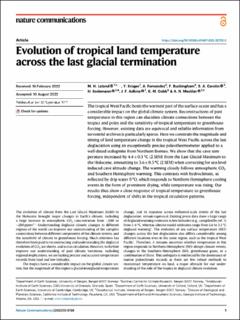| dc.contributor.author | Løland, Marit Holten | |
| dc.contributor.author | Krüger, Yves Stephan | |
| dc.contributor.author | Fernandez, Alvaro | |
| dc.contributor.author | Buckingham, Frances | |
| dc.contributor.author | Carolin, Stacy A. | |
| dc.contributor.author | Sodemann, Harald | |
| dc.contributor.author | Adkins, Jess F. | |
| dc.contributor.author | Cobb, Kim M. | |
| dc.contributor.author | Meckler, Anna Nele | |
| dc.date.accessioned | 2023-02-27T11:52:36Z | |
| dc.date.available | 2023-02-27T11:52:36Z | |
| dc.date.created | 2022-09-06T15:29:34Z | |
| dc.date.issued | 2022 | |
| dc.identifier.issn | 2041-1723 | |
| dc.identifier.uri | https://hdl.handle.net/11250/3054196 | |
| dc.description.abstract | The tropical West Pacific hosts the warmest part of the surface ocean and has a considerable impact on the global climate system. Reconstructions of past temperature in this region can elucidate climate connections between the tropics and poles and the sensitivity of tropical temperature to greenhouse forcing. However, existing data are equivocal and reliable information from terrestrial archives is particularly sparse. Here we constrain the magnitude and timing of land temperature change in the tropical West Pacific across the last deglaciation using an exceptionally precise paleothermometer applied to a well-dated stalagmite from Northern Borneo. We show that the cave temperature increased by 4.4 ± 0.3 °C (2 SEM) from the Last Glacial Maximum to the Holocene, amounting to 3.6 ± 0.3 °C (2 SEM) when correcting for sea-level induced cave altitude change. The warming closely follows atmospheric CO2 and Southern Hemisphere warming. This contrasts with hydroclimate, as reflected by drip water δ18O, which responds to Northern Hemisphere cooling events in the form of prominent drying, while temperature was rising. Our results thus show a close response of tropical temperature to greenhouse forcing, independent of shifts in the tropical circulation patterns. | en_US |
| dc.language.iso | eng | en_US |
| dc.publisher | Nature | en_US |
| dc.rights | Navngivelse 4.0 Internasjonal | * |
| dc.rights.uri | http://creativecommons.org/licenses/by/4.0/deed.no | * |
| dc.title | Evolution of tropical land temperature across the last glacial termination | en_US |
| dc.type | Journal article | en_US |
| dc.type | Peer reviewed | en_US |
| dc.description.version | publishedVersion | en_US |
| dc.rights.holder | Copyright 2022 The Author(s) | en_US |
| dc.source.articlenumber | 5158 | en_US |
| cristin.ispublished | true | |
| cristin.fulltext | original | |
| cristin.qualitycode | 2 | |
| dc.identifier.doi | 10.1038/s41467-022-32712-3 | |
| dc.identifier.cristin | 2049253 | |
| dc.source.journal | Nature Communications | en_US |
| dc.identifier.citation | Nature Communications. 2022, 13, 5158. | en_US |
| dc.source.volume | 13 | en_US |
| dc.source.issue | 1 | en_US |

